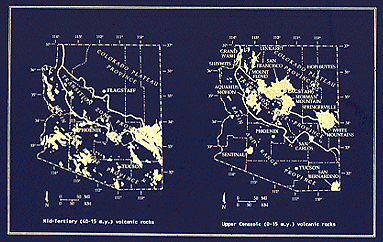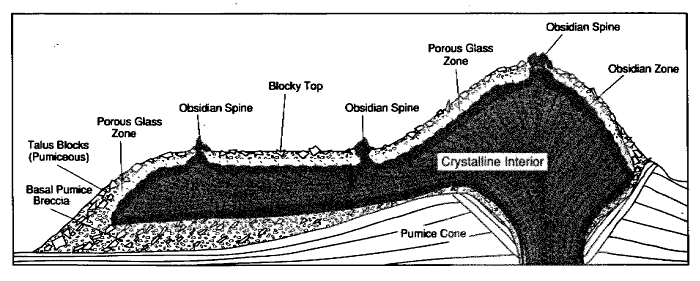THE HISTORY OF SILICIC VOLCANISM IN THE GREATER AMERICAN SOUTHWEST |
M. Steven Shackley
University of California at Berkeley
![]()

Location of Tertiary (left) through Cenozoic (right) volcanic fields in Arizona (from Reynolds et al.1986).
![]()
Although most volcanic environments are capable of producing obsidian, there are certain rather broad rules that govern its occurrence (Cann 1983; Shackley 2005). The most characteristic environment is in volcanic arcs and chains. Some of these arcs occur 100 to 200 km or more inland parallel to the margin of a continent at plate boundaries. This is the type of obsidian found around the Pacific Rim. Very similar volcanoes are found in chains across areas where oceans have been closed within the last 10 million years by the drift of continents. These are somewhat anomalous, but this pattern is responsible for many of the rhyolite extrusions in the Southwest, especially those in the southern half of Arizona in the Basin and Range Province (Reynolds et al. 1986). Within volcanic arcs, the most characteristic form of obsidian is alkaline or calc-alkaline, with a distinctive chemistry marked by high levels of calcium and alkalis and generally displaying gray or smoky-gray colors (Cann 1983; Shackley 1988). These obsidians generally show relatively high levels of barium and strontium. These glasses are generally the late Tertiary and Pleistocene rhyolites such as Cow Canyon, and the San Francisco Volcanic Field obsidians, particularly Government Mountain, Slate Mountain, and Kendrick Peak, and most of the Tertiary glasses in the Sonoran Desert. Also in volcanic arcs, some rhyolite lavas are found to be alkaline, but low in calcium. These are also considered to be calc-alkaline, but because of prolonged evolution or due to a different mode of origin, these lavas are depleted in calcium.
Sporadically within volcanic arcs and along some spreading plate boundaries, peralkaline lavas are erupted. These lavas have relatively high concentrations of iron, which gives the glass a characteristic green or brown cast in transmitted light, and often an opaque character. Zirconium is also relatively enriched and strontium depleted in these lavas. Peralkaline obsidians are not common north of the international border, but includes Antelope Wells. It appears that many of the as yet unlocated sources in the Sierra Madre Occidental (Chihuahua and Sonora) are peralkaline, as well as Los Sitios del Agua located southwest of Sonoyta, Sonora.
Middle to Late Tertiary Silicic Volcanism
As noted above, there have been two general periods of volcanism that are relevant for obsidian studies in the Southwest. During the middle to late Tertiary, particularly between the Oligocene and the Miocene, silicic volcanism was relatively common in Arizona, Sonora and western New Mexico (Nations and Stump 1981; Reynolds et al. 1986). A number of rhyolite extrusions produced glass, especially in central and south central Arizona. As mentioned earlier, the high water content in most of these lavas, however, created perlitic and devitrified fabrics (i.e. vitrophyres) that are unsuitable for tool production. Additionally, the 10+ million years since eruption has generally seen subsequent hydration of much of the vitreous glass originally extruded, further limiting the number of archaeologically relevant obsidians (see Cann 1983; Cox et al. 1979). Any vitreous obsidian left is in the form of marekanites or "Apache Tears", nodules generally less than 10 cm in diameter (Reynolds et al. 1986; Wilson and Roseveare 1945). These glass remnants can persist up to tens of millions of years under favorable conditions (Ross and Smith 1955). Many of these Tertiary sources seem to have been rhyolite domes where the outer margins cooled rapidly enough to produce a glass 'envelope' surrounding a non-glassy rhyolite core (see Zielinski et al. 1977:426). This applies certainly to Vulture, Sauceda Mountains, Superior, the Antelope Creek locality at Mule Creek, and Los Vidrios. Over time, the glassy envelope erodes and the nodules are released into, and help create, the Quaternary alluvium. The oldest Tertiary glasses are to the west (i.e. Tank Mountains and Sauceda Mountains) due to the apparent eastward migration of volcanism during this period (Reynolds et al. 1986; see the figure here). Given this, it would be unlikely to find quantities of knappable obsidian in far western Arizona, since the age would be simply too great for any glass to remain unhydrated to perlite. The Tank Mountains source in Yuma County is an exception that proves the rule. The remnant marekenites are very small. No nodules larger than three centimeters in diameter were located .

Stylized cross-section of a recent rhyolite extrusion producing aphyric obsidian. After millions of years, such as is the case with most of the Tertiary Southwestern obsidians, most of the porous glass zone and the obsidian contained there is eroded and becomes part of the regional alluvium. From Hughes and Smith (1993).
At least some of the marekenites were produced by other processes. At Mule Mountains and Los Vidrios marekenites were found in large ash flow units. Apparently, the marekenites were rhyolite pyroclasts quenched during the ash eruption.
While mid-Tertiary obsidian sources are relatively common in the Southwest, the small nodule sizes placed special constraints on the lithic technology, precluding large biface production and generally requiring bipolar reduction and conservation of the raw material (Shackley 1986b). The knapping quality of these small nodule sources is most often excellent, however, since the remnant glass may have been the most vitreous portion of the flow (Ross and Smith 1955). Interestingly, the two Clovis points produced from the Cow Canyon marekanite source (actually a Quaternary locality) recovered from the Murray Springs Clovis site in southeastern Arizona are well within the nodule size constraints of the Cow Canyon material; the complete Clovis specimen measures only 4.1 cm (Shackley 1988, 1990, 1995).
Middle Tertiary marekenites sources in the region include Antelope Wells, Burro Creek, Los Vidrios, Sauceda Mountains, Superior (Picketpost Mountain), Tank Mountains, and Vulture. Two other mid to late Tertiary sources in western New Mexico also produce small nodules, but in the form of ash flow pyroclasts as discussed above. The Mule Creek regional source in west central New Mexico is the result of a large silicic ash-fall eruption that included small glassy pyroclasts. The Red Hill regional source is found today in a predominantly basalt alluvium; the original rhyolite eruption was apparently covered by later mafic volcanism or may be related to it (Willard and Weber 1958). The nodules are scattered within the basalt regolith, and interestingly, the glass exhibits a variety of mafic micro-phenocrysts (Burton 1986).
Upper Cenozoic Silicic Volcanism
The early (Tertiary) period of volcanism was followed in the Quaternary by another cycle of eruptive events primarily along the southern boundary of the Colorado Plateau north and east of the earlier activity (Reynolds et al. 1986). These rhyolite/obsidian eruptions are often characterized by larger nodules, due mainly to the more recent activity and possibly, in the case of the San Francisco and Mount Floyd fields, eruption in very cold high altitude environments which facilitated rapid cooling of large silicic lava flows (Robinson 1913). Some of these nodules approach 30 centimeters or more in diameter, but the knapping quality rarely approaches that produced in the southern marekanites sources (Shackley 1988, 1990). Quaternary sources of obsidian include all localities in the San Francisco and Mount Floyd Volcanic Fields in northern Arizona, and the obsidian along the Rio Grande Rift in central and northern New Mexico (not discussed here; see Hughes 1988a; and Newman and Nielsen 1985, 1987). The ages of these sources are generally in the tens of thousands of years rather than in tens of millions of years common for the marekanites sources, and seem to be related to the decrease in the dip of the subducted oceanic Farallon plate (Coney and Reynolds 1977; Reynolds et al. 1986).
The silicic volcanic eruptive history in the Southwest directly influenced the technology and procurement behavior of the prehistoric groups (see Torrence 1986 for similar patterns in the Aegean). The small marekanites provided excellent knapping material, but required rather specialized technology such as bipolar reduction and conservation (see Kelly 1985; Shackley 1985). The large nodule sources in the San Francisco and Mount Floyd fields generally produced somewhat inferior but still very good raw material.
REFERENCE
Hughes, Richard E., and Robert L. Smith 1993 Archaeology, Geology, and Geochemistry in Obsidian Provenance Studies. In Scale on Archaeological and Geoscientific Perspectives, edited by J.K. Stein and A.R. Linse, pp. 79-91. Geological Society of America Special Paper 283.
Shackley, M.S. (2005) Obsidian: Geology and Archaeology in the North American Southwest. University of Arizona Press, Tucson.
![]()
This page maintained by Steve Shackley (shackley@berkeley.edu).
Copyright © 2009 M. Steven Shackley. All rights reserved.
Revised: Wednesday, 19 August 2015
![]() Back to
the SW obsidian source page
Back to
the SW obsidian source page
![]()